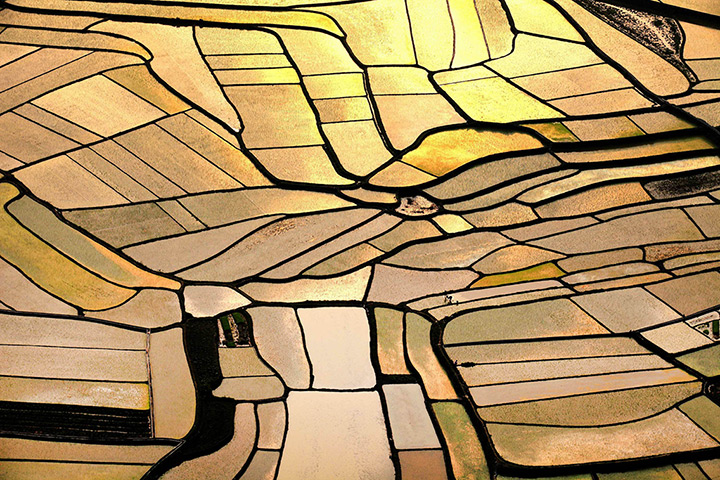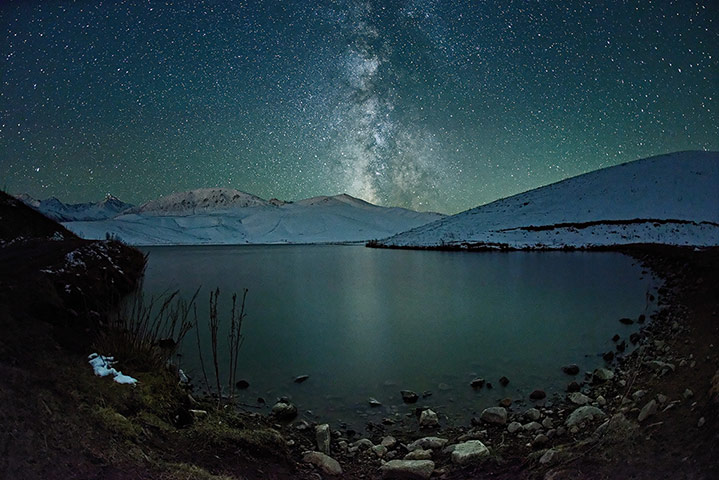There is no doubt that landscape photography is popular, but is it really important? When people take photography seriously, they almost always are doing so to focus on the people who are being shown. War, poverty, politics, sports–whatever the subject, the point is to show what people are doing and experiencing. They are shown in specific circumstances, but there is no doubt that who matters more than where.
So why would we value an image that shows us only the land, the flow of light over a hill, and the ease with which the earth exceeds human scale? Perhaps this photograph from Donglan county, Jiangping, Cbina isn’t the best example, as it allows a concession for admiring human handiwork. The exquisitely fitted paddy fields are the result of many generations of careful agriculture, and if their beauty, as if fine jewelry, can’t be appreciated from the ground, they are no less artfully wrought for that.
Like any garden, most landscapes reflect human engineering of one sort or another–and not least the framing and other artistry provided by the camera–so perhaps it’s not such a bad example after all. The landscape could be a subtle exercise in narcissism: Humans can pretend that they are looking at nature while actually admiring their own reflection. Or these photos could be another form of vanity: suggesting an easy harmony between humanity and nature (and perhaps nature’s God). Such photos rarely feature nature’s harshness, where animals will eat their prey before it dies, and in any case the camera will not let you feel how cold the desert gets at night or how flies can drive you mad.
Some landscapes have been put to very good use, and very serious use, in the service of the environmental movement. With images from Ansel Adams’ portraits of Yosemite to the Earthrise on the cover of the Whole Earth Catalog to the successive Sierra Club magazine covers to the many documentaries of environmental degradation, landscape photography has been a powerful means for political advocacy on behalf of a planet that cannot speak for itself.
I wouldn’t want to leave it there, however. At some point, the environmentalism (which includes some posts at this blog) overwrites the images; they become merely means to an end, rather than something also capable of guiding other forms of reflection. Let me suggest one such alternative, one that is consistent with an environmental ethos but not the same thing either.
Whatever else it is, the landscape photograph can be an image of abundance. Whether capturing purple mountain majesties or the traces of the wind on a barren sand dune, the landscape shows a world that is immensely larger, more interconnected, more amazing than anything any human society will ever make. Buddhism has tried to capture that immensity, and to contrast it to the paucity of human meaning-making, but I’m not sure the Abrahamic religions and the civilizations they are part of have an equivalent point of departure. Sure, there are Biblical passages celebrating cosmic power, but that’s just the beginning of how one might marvel at the richness of this planet in this universe.
None of this denies the role of scarcity in nature or human affairs. Indeed, the photograph above can be seen as a subtle meditation of how to build a sustainable relationship with scarcity on behalf of abundance. But often abundance is misunderstood and under appreciated (“under theorized,” as they say on my side of the street). A few have approached it–Georges Bataille, Paul Feyerabend, Anne Norton–but an abundance of writing on the subject is not yet the norm.
I don’t think complaints about over-consumption qualify as a sufficient account of abundance, as they presume a more beneficial scarcity. And don’t conclude that this post a brief for obesity, gluttonous oil consumption, or other dysfunctional or non-sustainable habits that harm individuals, society, and the environment. Both abundance and scarcity need to be understood apart from contemporary extremes, not least if we are to see how often those extremes are artificial rather than natural conditions.
Whatever has been said, I doubt that it begins to articulate how much we could learn, and how well we could live, if we were to really look at what landscapes can reveal.
Photographs by Xinhua/Landov/Barcroft Media and Elmar Akhmetov/Sony World Photography 2013 award.


I’ve been a follower of Ansel Adams for a long time as his photos aren’t just of places like Yosemite but for me they capture the emotion of being there. I spent a long time learning how to use Adams’ method of turning sound into light values — he initially trained as a concert pianist — and then went on from his black and white renderings to color which has hue, value (lightness), and chroma (color purity). My method of understanding Adams is to look for a pure black, a pure white which lay out an octave and then look for value 7 for black and white and/or a color that has the purest color. You can “hear” these colors with the opening of sight and sounds in the movie “2001: A Space Odyssey” which come from the initial fanfare — entitled “Sunrise” in the tone poem “Thus spoke Zarathustra” by Richard Strauss. I hear it playing in my mind when I look at the last photo …
I prefer photos that have content as well as composition. Waterfalls seem to be a popular subject for some photographers, but having a tin ear, most waterfalls look and sound alike to me.
I suppose different people bring different perspcctives to photographs. The paddy fields photo seems to be sprayed all over the internet. But severe drought conditions existed in that county in the last couple of years, and I wonder to what extent the photo is part of the governments “nothing to see here” promotion. The photo did not come from some farmer out for a joy ride in his plane on a beautiful summer morning.
But without any information on drought, the irregular patterns say something else to me. I see imperfect property rights, land divided and redivided over time as families grow, and very low productivity of labor in farming. All hand work. No machines. Bucolic, yes. Productive, perhaps. Terribly hard work for little pay, with little prospect of change, certainly.
Bill provides an important perspective that I should have noted, not least because I’ve said so before: http://www.nocaptionneeded.com/2008/03/radiant-agriculture/ There are layers of complexity to abundance, and paradoxes as well.